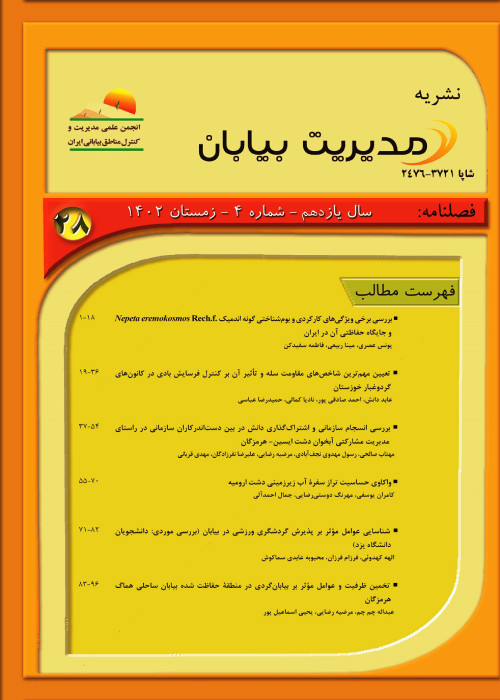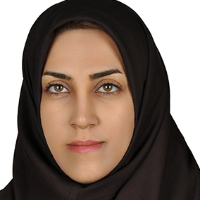Estimating the Potential and Factors Affecting Desert Tourism in Protected Areas of Coastal Deserts (Case study: Hemag Protected Area of Hormozgan)
Author(s):
Article Type:
Research/Original Article (دارای رتبه معتبر)
Abstract:
Introduction
More than 40% of Iran's borders are situated on the sea and are considered desert areas. These coastal deserts are only located in three provinces: Hormozgan, Sistan, Baluchistan, and Khuzestan. There are a lot of geotourism attractions in these areas. The desert ecotourism industry, which is situated close to the ocean and open sea, has a significant impact on the economy of the local desert communities and increasing the gross domestic income of Iran. Qatar is known as the center of coastal desert tourism in the world. Although there is a lot of potential in these southern provinces, the coastal desert tourism industry in Iran remains undeveloped and neglected. The tourism industry accounts for more than 50% of the economy in developed countries with a sea border. Visiting the natural and visual attractions of the beaches, particularly the neighboring desert beaches, is a major source of income for both domestic and foreign tourists every year. The economic contribution of sea-related industries, particularly tourism, to Iran's economy is less than 0.01%. The tourism industry, particularly the desert tourism branch, has not been growing and developing despite the high capability of desert attractions and ecosystems, unfortunately. Assessing the ecological potential and merit of arid and semi-arid areas is a process that aims to promote appropriate and harmonious development. with nature, regulate the relationship between man and nature. This assessment is an effective way to get a plan for sustainable development. Development plans can be made in harmony with nature by identifying and evaluating the ecological characteristics in each region. This research aims to assess the suitability of land and its environmental capacity for optimal use, taking into account factors such as characteristics of vegetation and fauna, topography, soil science, climate, access to roads, cities, and water sources, etc. to examine their limitations for exploiting the desired deserts.Material and Methods
The Hemag protected area is situated in Hormozgan province It is located in between the geographic coordinates of 25° 24 ʹ to 28° 57 ʹ north latitude and 53° 41 ʹ to 59° 15 ʹ east longitude from the Greenwich Meridian and can be found in the north of Bandar Abbas city and the southern part of Haji Abad city. This protected area with an area of 100,509 ha, consists of parts of the huge Hemag mountain range. The climate of this region is different from that of other parts of Hormozgan province due to its mountainous nature. To determine the suitability of desert tourism in the region, FAO's restrictive guidelines were used by using GIS. After determining the effective factors and ranking them, the most significant effective factors from FAO (1991) were added to the model. Six sub-models were established, with topography (height and slope), soil (soil texture), climate, water resources, vegetation, and natural attractions being the most important. Slope is an important parameter in determining the degree of sustainability. Makhdoom (2012)'s sustainability classes for extensive recreation indicated that the slope factor's sustainability classes were classified in the tourism model of the region. The elevation parameter plays a significant role in tourist use by affecting the characteristics of temperature, quality, density, and diversity of vegetation, leading to a beautiful landscape and pleasant climate.
Results and Discussion
The model results show that the S1 class covers 35,498.1 ha (39.39) while the S2 class covers 32097.35 ha (30.6). The S3 class received 18983 ha (20%), while the N class received 3821.05 ha (4.3%). The results of the sustainability classes of the height model show that 235.3 ha out of the area of 90400, have a height of more than 1800 m and in the sustainability class S1. About 424.2 ha (25.31%) ranked in the sustainability class S2 with an elevation between 1400 to 1800 m, and 5.27936 ha (90.30%) is put in the sustainability class S3 with an elevation between 1000 to 1400 m. There is approximately 841.1460 ha (61.1%) that falls under the N sustainability category and is located under 1000 m elevation. According to the suitability classes of the soil model, 13442.5 ha (14.8%) are classified as S1 class. The S2 competence class accounts for 74949 ha (82.91%), while the N sustainability class accounts for 2008 ha (22.2%). According to the final tourism sustainability model, 39,022 ha (43.17%) are classified as S1 sustainability class out of 90,400 ha. The S2 sustainability class holds 35,822 ha (39.63%), while S3 sustainability class holds 8.8 6236 ha (6.9%), and N sustainability class holds 9319.01 ha (10.3%). According to the final model's results, the region is in the medium sustainability category for desert tourism. The region's tourism and desert tourism are restricted by certain factors that increase and decrease. Many researchers have found that the slope is a significant factor in the capacity of an area for recreation and desert tourism. According to the habitat suitability map of the carnivore, the highest concentration is found in the low suitability category. In the region, there are also herbivores including Gasella benetti and Ovis orientalis, and the results indicate that these herbivores are very suitable for sustainability in the region. The more wildlife that is present, the more attractive these areas are to tourists. The most significant reason for the lack of suitability in terms of numbers was the lack of wildlife in the region, according to the results of the suitability test.Keywords:
Language:
Persian
Published:
Desert Management, Volume:11 Issue: 28, 2024
Pages:
83 to 96
magiran.com/p2702502
دانلود و مطالعه متن این مقاله با یکی از روشهای زیر امکان پذیر است:
اشتراک شخصی
با عضویت و پرداخت آنلاین حق اشتراک یکساله به مبلغ 1,390,000ريال میتوانید 70 عنوان مطلب دانلود کنید!
اشتراک سازمانی
به کتابخانه دانشگاه یا محل کار خود پیشنهاد کنید تا اشتراک سازمانی این پایگاه را برای دسترسی نامحدود همه کاربران به متن مطالب تهیه نمایند!
توجه!
- حق عضویت دریافتی صرف حمایت از نشریات عضو و نگهداری، تکمیل و توسعه مگیران میشود.
- پرداخت حق اشتراک و دانلود مقالات اجازه بازنشر آن در سایر رسانههای چاپی و دیجیتال را به کاربر نمیدهد.
In order to view content subscription is required
Personal subscription
Subscribe magiran.com for 70 € euros via PayPal and download 70 articles during a year.
Organization subscription
Please contact us to subscribe your university or library for unlimited access!



